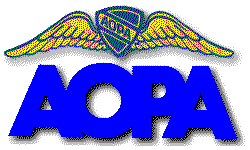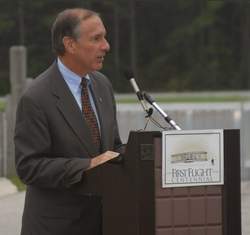First-Ever Meeting With FBI And Secret Service
 After months
of demands for a dialogue with all federal agencies that make
decisions about airport and airspace security, AOPA and other
industry organizations finally had the chance to sit down with
government representatives during a meeting Friday at FAA
headquarters.
After months
of demands for a dialogue with all federal agencies that make
decisions about airport and airspace security, AOPA and other
industry organizations finally had the chance to sit down with
government representatives during a meeting Friday at FAA
headquarters.
The meeting was the first among AOPA, the FBI and the
Secret Service. Five other government agencies also took part. Six
industry organizations, representing every aspect of general
aviation from helicopters to charter operators, presented the
positions to the government's Interagency Group, which is tasked
with coordinating airspace control measures.
Telling It Like It Is
 AOPA President Phil Boyer presented a very candid
picture of the typical GA pilot and the impact the airspace rules
were imposing on the pilot and owner directly.
AOPA President Phil Boyer presented a very candid
picture of the typical GA pilot and the impact the airspace rules
were imposing on the pilot and owner directly.
"I'm not going to tell you all AOPA pilots are out saving lives,
fighting fires, doing electronic news gathering, or chartering
their planes," Boyer told the gathering. "GA pilots are using these
airplanes with three to four seats on average, in a single-engine,
fixed-gear aircraft basically for personal and business
transportation.
"Probably the proudest thing you could have, just like a car
when you were 16, 17, or maybe you had to wait until 20, 21, or
whatever, are the keys to one of these general aviation airplanes."
At this point, Boyer held up the keys to his personal aircraft, a
Cessna 172. "You'd be an owner; you now have an asset that to these
people is very important."
 Boyer
pointed out that the financial commitment that pilot/owners make
goes far beyond just owning the aircraft. "Just about 40
miles away at Frederick (MD), the hangar for the airplane that goes
with these keys is $325 a month; insurance is about $150 a month,
and the maintenance on that airplane, that is required by the
Federal Aviation Administration regulations, about another $150 a
month. So before you even take the airplane out of the hangar,
there's an outpouring of $650 to $700 a month that these people
have made as their commitment to aircraft ownership. ... Many will
just decide not to keep this valuable asset any longer.
Boyer
pointed out that the financial commitment that pilot/owners make
goes far beyond just owning the aircraft. "Just about 40
miles away at Frederick (MD), the hangar for the airplane that goes
with these keys is $325 a month; insurance is about $150 a month,
and the maintenance on that airplane, that is required by the
Federal Aviation Administration regulations, about another $150 a
month. So before you even take the airplane out of the hangar,
there's an outpouring of $650 to $700 a month that these people
have made as their commitment to aircraft ownership. ... Many will
just decide not to keep this valuable asset any longer.
"I represent pilots, and the best way to understand them is to
hear the kinds of comments they are sending us, as their
representative. I'm going to limit these to operational comments,
not comments that have four-letter words in them and negatives
about our government's thinking power.
" 'Instructors are having trouble convincing students to
continue their flight training because they don't find this
anywhere near enjoyable.'
" 'There is an insidious effect of fewer flying opportunities,
fewer active pilots. Already our club has lost 3 pilot members in
the last month that decided to save themselves money until the
situation improves.'
"I have to personally answer emails and phone calls. Our AOPA
staff of 225 employees hear from members every single day. The one
question I can't answer now is ... 'Phil, should I turn my airplane
keys in now, or are they going to be worthless sometime later?'" at
which point, Boyer placed his aircraft keys on the table.
Ending On A Promising Note
 The
meeting closed with "a pledge" from both the Department of Homeland
Security and the Department of Defense to more closely cooperate
with AOPA and to offer a forum for operational solutions to their
security concerns. Boyer and AOPA Senior Vice President of
Government and Technical Affairs Andy Cebula took this as a firm
follow-up commitment with the agencies that the association has not
deal with in the past.
The
meeting closed with "a pledge" from both the Department of Homeland
Security and the Department of Defense to more closely cooperate
with AOPA and to offer a forum for operational solutions to their
security concerns. Boyer and AOPA Senior Vice President of
Government and Technical Affairs Andy Cebula took this as a firm
follow-up commitment with the agencies that the association has not
deal with in the past.
As members of the Interagency Group, AOPA now not only has
direct contact with the FBI and Secret Service, but also continues
to have a very direct working relationship with the Federal
Aviation Administration (FAA); the Transportation Security
Administration (TSA); the Department of Homeland Security (DHS);
the Department of Defense (DOD), and the Bureau of Immigration and
Custom Enforcement.
FMI:
Transcript of Phil Boyer's comments
 ANN's Daily Aero-Term (04.24.24): Runway Lead-in Light System
ANN's Daily Aero-Term (04.24.24): Runway Lead-in Light System ANN's Daily Aero-Linx (04.24.24)
ANN's Daily Aero-Linx (04.24.24) Aero-FAQ: Dave Juwel's Aviation Marketing Stories -- ITBOA BNITBOB
Aero-FAQ: Dave Juwel's Aviation Marketing Stories -- ITBOA BNITBOB Classic Aero-TV: Best Seat in The House -- 'Inside' The AeroShell Aerobatic Team
Classic Aero-TV: Best Seat in The House -- 'Inside' The AeroShell Aerobatic Team Airborne Affordable Flyers 04.18.24: CarbonCub UL, Fisher, Affordable Flyer Expo
Airborne Affordable Flyers 04.18.24: CarbonCub UL, Fisher, Affordable Flyer Expo






